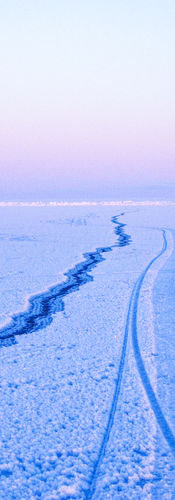
ᑐᕙᖅ
[SEA ICE]
SEA ICE
To travel and hunt safely it is important to know about ice and ice conditions. This is especially true at the times just after freeze-up and just before break-up when the ice is thin. There are also places on the sea ice where it is unsafe to travel at any time of the year. We also have to be very careful when hunting at the floe-edge. Because Igloolik is situated on a small island, almost all travel takes place on the sea. Hunting, fishing and travel to the communities of Ikpiarjuk (Arctic Bay), Mittimatalik (Pond Inlet), Kangiqtugaapik (Clyde River), Naujaat (Repulse Bay), and Sanirajak (Hall Beach) all involve crossing large areas of sea ice. Except for the short open water season from late July to the end of October, Iglulingmiut travel on the sea ice for most of the year. In earlier times, they even lived on the sea ice during the spring to be closer to good hunting.

LIVING on the SEA ICE
One of the most important ice camps was located just North of Igloolik. The camp was set up near a very long ice ridge that forms every year nearly at the same location. This camp was called Aggiuppiniit, meaning "the ice ridge", where Inuit would hunt seals at a large crack or ice lead known as Naggutialuk. This camp sometimes had up to 100 people living in it. Some elders say that living on the sea ice was warmer than living on the land. They used to get material for their bed platforms on the nearby island of Nirlirnaqtuuq.
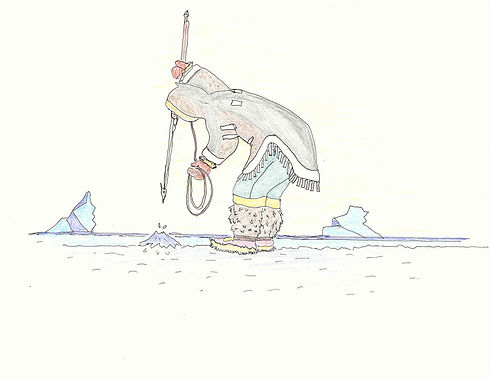
A journey over the sea ice near Pond Inlet, Nunavut.
AGIUPPINIIT
Louis Alianakuluk and Aipilik Innuksuk lived in Agiuppiniit as children and share their memories of what life was like in the camp.
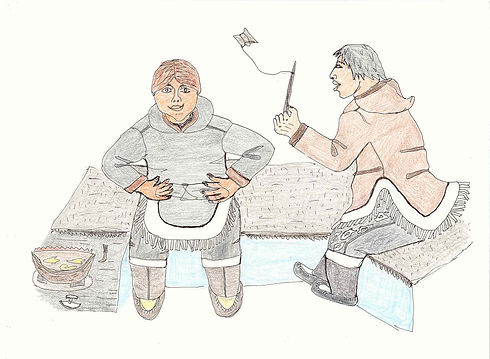

AIPILIK INNUKSUK
on life at the Agiuppiniit camp.
"WE USED TO LIVE IN A QARMAQ (a sod house), at least this is what we did - I and my adopted parents. I had not lived in an igloo while we were in this area. All we lived in was a qarmaq. Towards the spring, when it was necessary to move close to the floe-edge they would make their dwelling in an igloo at Iglulik [Igloolik Point]. Sometimes, they would go elsewhere, in particular to the landfast ice at Agiuppiniq from Avvajja. This location was suitable for the hunters that would hunt on the ice through seal breathing holes on Ikiq. The place that I refer to as Agiuppiniq is located in this area. When the ice had started to freeze over the first freeze-up stage usually happens among the grounded ice floes where the first floe-edge would be located. We used to make our home just past the area where there is no danger of the ice breaking up and carrying us out to sea. The build-up of pressure ridges, caused by the moving ice before it freezes off Nirlirnaqtuuq, is called Agiuppiniq" (Aipilik Innuksuk IE-004, 1986).

LOUIS ALIANAKULUK
on life at the Agiuppiniit camp.
[Swipe right for continued
translation below >>> ]
TUVAQ
Tuvaq is the landfast sea ice that forms at freeze-up in October and stays until late spring. It is over this ice that most of the travelling is done from Igloolik. Each year the sea ice has features such as ridges, cracks and especially the floe-edge, which form at almost the same places. These places are known and used by experienced hunters.
Having a good knowledge of the sea ice and its features involves understanding local land formations, winds, currents and tides.
Maurice Arnatsiaq on Tuvaq.

EMILE IMARUITUQ
on the stages sea ice freeze-up near Igloolik.
[Swipe right for continued
translation below >>> ]
TUVAQ MAP
Tuvaq has features that form each year more or less in the same locations. This map marks some of these features near Igloolik.
Click right to scroll through the stages of the freeze-up at Igloolik.
AULAJUQ
Around Igloolik, Inuit are used to hunting at the floe-edge and on the moving ice. The dark reflection in the sky of the open water at the floe-edge can be see from far away. This reflection is called tunguniq. The moving ice beyond the floe-edge is a good place to hunt walrus. The moving ice is brought in and taken away again and again by the tides and the wind. In the past, to be closer to the floe-edge the people of the Igloolik area set-up their camps at three main locations: Ugliit, Iglulik [Igloolik Point], and Pingiqqalik.
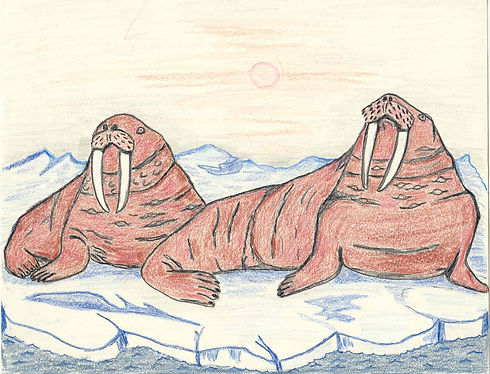

NOAH PIUGAATTUK
on life at Ugliit and Piniggalik.
[Swipe right for continued
translation below >>> ]
AULAJUQ and WINDS
Before going onto the moving ice, or when hunting at the floe-edge, experienced hunters always observe the wind conditions and the tides. Wind direction and strength are important for determining conditions at the floe-edge. When the Uangnaq wind blows, the aulajuq ice is moved away from the floe-edge. When this happens it is a good time for hunting seals at the floe-edge. When the wind changes to Nigiq, the aulajuq comes back to the floe-edge, making it possible for experienced hunters to hunt walrus on the moving ice. Hunting on the aulajuq can be very dangerous because changes in wind direction and tide currents can prevent you from getting back to the tuvaq.
Maurice Arnatsiaq on Aulajuq.

PIUGAATTUK,
on hunting and the effects of the winds at floe-edge.
[Swipe right for continued
translation below >>> ]
AULAJUQ and the
FLOE-EDGE
This animation shows the aulajuq ice near Igloolik. The winds will enable different effects on the sea ice in other locations.
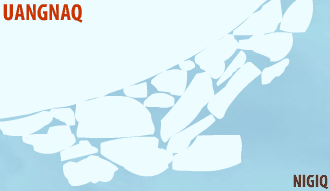
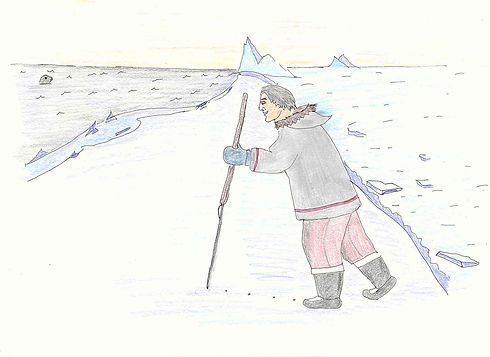

AIPILIK INNUKSUK
on the moving ice at the floe-edge near Igloolik.
[Swipe right for continued
translation below >>> ]
AULAJUQ and the TIDES
The tides and currents as well as the winds cause the aulajuq to move. For this reason, hunters always have to be aware of the tides and remember that tides are strongest during the new moon (taqqiila) and full moon (naaqquruktuq).
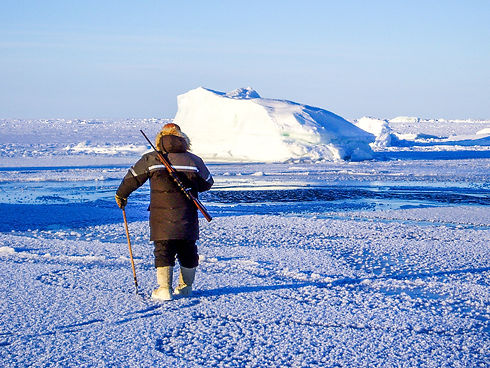

ALIANAKULUK,
on the importance of knowing tidal currents.
"IF YOU PLAN ON spending day after day on the ice hunting, you must always pay attention to the tidal currents, especially in the winter when the temperatures are extreme. The ice tends to break off and detach itself from the landfast ice. It is dangerous when you do not pay attention; it may even look as if it would not break off. For generations it has been like this: the floe-edge always wants to break off. This is especially the case after the ice has formed at the floe-edge for a prolonged period and there has been no open water. It is said that when it wants to break off, it will break off anywhere it desires, especially when the tidal currents are strong during spring tide, even when it appears to be stable. It has been said that when the floe-edge gets the urge to become open water the ice breaks off" (Louis Alianakuluk IE-477, 2001).

INNUKSUK,
on the importance of knowing tidal currents.
[Swipe right for continued
translation below >>> ]
SEA ICE GALLERIES
Check out the many forms of the in the Igloolik area by clicking through the gallery below.







